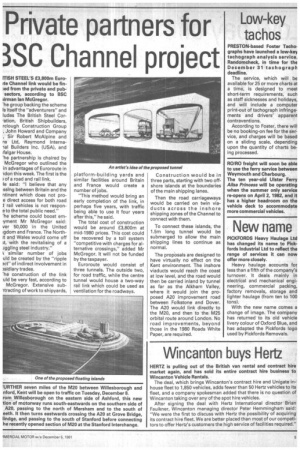Private partners for )SC Channel project
Page 5

If you've noticed an error in this article please click here to report it so we can fix it.
ITISH STEEL'S £3,800m Eurorte Channel link would be fined from the private and pubsectors, according to BSC airman Ian McGregor.
he group backing the scheme Is itself the "adventurers" and ludes The British Steel Cor-ation, British Shipbuilders, rclough Construction Group , John Howard and Company , Sir Robert McAlpine and ns Ltd, Raymond Internelel Builders Inc. {USA), and ifalgar House.
he partnership is chaired by McGregor who outlined the in advantages of Euroroute in ,don this week. The first is the of a road and rail link.
le said: "I believe that any ssing between Britain and the itinent which does not proe direct access for both road rail vehicles is not respone to the total public need."
he scheme could boost emyment Mr McGregor said: ver 50,000 in the United igdom and France. The Northit and Wales would come off rt, with the revitalising of a Jggling steel industry."
k similar number of jobs uld be created by the "ripple act" of indirect involvement in midiary trades.
he construction of the link uld be very fast, according to McGregor. Extensive subnracting of work to shipyards,
platform-building yards and similar facilities around Britain and France would create a number of jobs.
"This method would bring an early completion of the link, in perhaps five years, with traffic being able to use it four years after this," he said.
The total cost of construction would be around £3,800m at mid-1980 prices. This cost could be recovered by a toll system "competitive with charges for alternative crossings," added Mr McGregor. It will not be funded by the taxpayer.
Euroroute would consist of three tunnels. The outside two, for road traffic, while the centre tunnel would house a two-way rail link which could be used as ventilation for the roadways. Construction would be in three parts, starting with two offshore islands at the boundaries of the main shipping lanes.
Then the road carriageways would be carried on twin viaducts across the inshore shipping zones of the Channel to connect with them.
To connect these islands, the 1.5m long tunnel would be submerged to allow the main shipping lines to continue as normal.
The proposals are designed to have virtually no effect on the Kent environment. The inshore viaducts would reach the coast at low level, and the road would then be carried inland by tunnel as far as the Alkham Valley, where it would join the proposed A20 improvement road between Folkstone and Dover. The A20 would link directly to the M20, and then to the M25 orbital route around London. No road improvements, beyond those in the 1980 Roads White Paper, are required.


































































